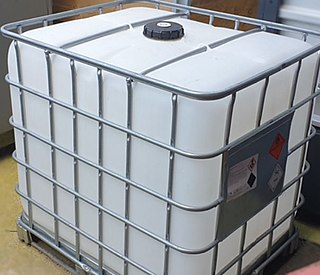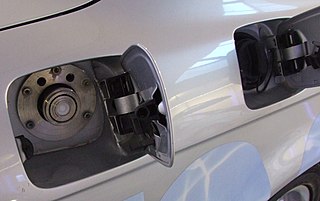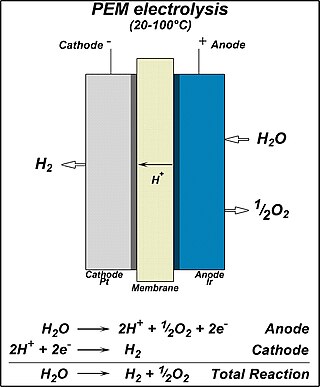This is a timeline of the history of hydrogen technology.
Contents
- Timeline
- 16th century
- 17th century
- 18th century
- 19th century
- 20th century
- 21st century
- See also
- References

This is a timeline of the history of hydrogen technology.

This section has multiple issues. Please help improve it or discuss these issues on the talk page . (Learn how and when to remove these template messages)
|

A fuel cell is an electrochemical cell that converts the chemical energy of a fuel and an oxidizing agent into electricity through a pair of redox reactions. Fuel cells are different from most batteries in requiring a continuous source of fuel and oxygen to sustain the chemical reaction, whereas in a battery the chemical energy usually comes from substances that are already present in the battery. Fuel cells can produce electricity continuously for as long as fuel and oxygen are supplied.

Hydrogen is a chemical element; it has symbol H and atomic number 1. It is the lightest element and, at standard conditions, is a gas of diatomic molecules with the formula H2, sometimes called dihydrogen, but more commonly called hydrogen gas, molecular hydrogen or simply hydrogen. It is colorless, odorless, tasteless, non-toxic, and highly combustible. Constituting approximately 75% of all normal matter, hydrogen is the most abundant chemical substance in the universe. Stars, including the Sun, primarily consist of hydrogen in a plasma state, while on Earth, hydrogen is found in water, organic compounds, and other molecular forms. The most common isotope of hydrogen consists of one proton, one electron, and no neutrons.

Liquid hydrogen (H2(l)) is the liquid state of the element hydrogen. Hydrogen is found naturally in the molecular H2 form.
Syngas, or synthesis gas, is a mixture of hydrogen and carbon monoxide, in various ratios. The gas often contains some carbon dioxide and methane. It is principally used for producing ammonia or methanol. Syngas is combustible and can be used as a fuel. Historically, it has been used as a replacement for gasoline, when gasoline supply has been limited; for example, wood gas was used to power cars in Europe during WWII.

The hydrogen economy is an umbrella term that draws together the roles hydrogen can play alongside low-carbon electricity to decarbonize those sectors and activities which may be technically difficult to decarbonize through other means, or where cheaper and more energy-efficient clean solutions are not available. In this context, hydrogen economy encompasses hydrogen's production through to end-uses in ways that substantively contribute to phasing-out fossil fuels and limiting climate change.
The water fuel cell is a non-functional design for a "perpetual motion machine" created by Stanley Allen Meyer. Meyer claimed that a car retrofitted with the device could use water as fuel instead of gasoline. Meyer's claims about his "Water Fuel Cell" and the car that it powered were found to be fraudulent by an Ohio court in 1996.

The methanol economy is a suggested future economy in which methanol and dimethyl ether replace fossil fuels as a means of energy storage, ground transportation fuel, and raw material for synthetic hydrocarbons and their products. It offers an alternative to the proposed hydrogen economy or ethanol economy, although these concepts are not exclusive. Methanol can be produced from a variety of sources including fossil fuels as well as agricultural products and municipal waste, wood and varied biomass. It can also be made from chemical recycling of carbon dioxide.
Hydrogen gas is produced by several industrial methods. Fossil fuels are the dominant source of hydrogen. As of 2020, the majority of hydrogen (~95%) is produced by steam reforming of natural gas and other light hydrocarbons, and partial oxidation of heavier hydrocarbons. Other methods of hydrogen production include biomass gasification and methane pyrolysis. Methane pyrolysis and water electrolysis can use any source of electricity including renewable energy.
Hydrogen technologies are technologies that relate to the production and use of hydrogen as a part hydrogen economy. Hydrogen technologies are applicable for many uses.
A water-fuelled car is an automobile that hypothetically derives its energy directly from water. Water-fuelled cars have been the subject of numerous international patents, newspaper and popular science magazine articles, local television news coverage, and websites. The claims for these devices have been found to be pseudoscience and some were found to be tied to investment frauds. These vehicles may be claimed to produce fuel from water on board with no other energy input, or may be a hybrid claiming to derive some of its energy from water in addition to a conventional source.
The 42' sailboat known as the XV/1 was intended to demonstrate Haveblue LLC's patented technology for the production, storage, and use of hydrogen on board a marine vessel. The anticipated range was to be a radius of ~300 nautical miles at 8 knots on a full tank.
The Glossary of fuel cell terms lists the definitions of many terms used within the fuel cell industry. The terms in this fuel cell glossary may be used by fuel cell industry associations, in education material and fuel cell codes and standards to name but a few.
The static buoyancy of airships in flight is not constant. It is therefore necessary to control the altitude of an airship by controlling its buoyancy: buoyancy compensation.

A hydrogen internal combustion engine vehicle (HICEV) is a type of hydrogen vehicle using an internal combustion engine. Hydrogen internal combustion engine vehicles are different from hydrogen fuel cell vehicles. Instead, the hydrogen internal combustion engine is simply a modified version of the traditional gasoline-powered internal combustion engine. The absence of carbon means that no CO2 is produced, which eliminates the main greenhouse gas emission of a conventional petroleum engine.

Proton exchange membrane(PEM) electrolysis is the electrolysis of water in a cell equipped with a solid polymer electrolyte (SPE) that is responsible for the conduction of protons, separation of product gases, and electrical insulation of the electrodes. The PEM electrolyzer was introduced to overcome the issues of partial load, low current density, and low pressure operation currently plaguing the alkaline electrolyzer. It involves a proton-exchange membrane.
Hydrogenics is a developer and manufacturer of hydrogen generation and fuel cell products based on water electrolysis and proton-exchange membrane (PEM) technology. Hydrogenics is divided into two business units: OnSite Generation and Power Systems. Onsite Generation is headquartered in Oevel, Belgium and had 73 full-time employees as of December 2013. Power Systems is based in Mississauga, Ontario, Canada, with a satellite facility in Gladbeck, Germany. It had 62 full-time employees as of December 2013. Hydrogenics maintains operations in Belgium, Canada and Germany with satellite offices in the United States, Indonesia, Malaysia and Russia.
NASA's Pathfinder Technology Demonstrator (PTD) Project is a series of tech demonstrations of technologies aboard a series of nanosatellites known as CubeSats, providing significant enhancements to the performance of these versatile spacecraft. Each of the five planned PTD missions consist of a 6-unit (6U) CubeSat with expandable solar arrays.
Aircraft engine performance refers to factors including thrust or shaft power for fuel consumed, weight, cost, outside dimensions and life. It includes meeting regulated environmental limits which apply to emissions of noise and chemical pollutants, and regulated safety aspects which require a design that can safely tolerate environmental hazards such as birds, rain, hail and icing conditions. It is the end product that an engine company sells.

A solar hydrogen panel is a device for artificial photosynthesis that produces photohydrogen directly from sunlight and water vapor utilizing photocatalytic water splitting and thus bypasses the conversion losses of the classical solar–hydrogen energy cycle where solar power is first harvested with solar panels and only then converted to hydrogen with electrolysis plants.
A research team in Belgium says its prototype panel can produce 250 liters of hydrogen gas per day